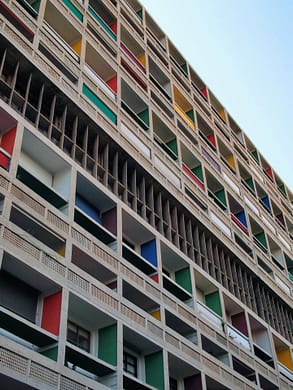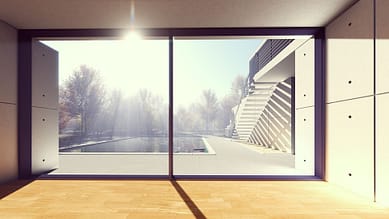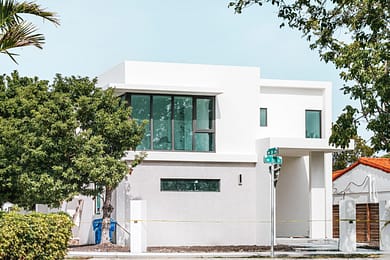Le Corbusier, a timeless architecture
BY LAETITIA NEIER
 The architect Le Corbusier, real name Charles-Edouard Jeanneret (1887 La Chaux-de-Fonds – 1965 Roquebrune-Cap-Martin, FR) is one of the great representatives of the movement of modern architecture that flourished at the beginning of the 20th century. As one of the first internationally active architects, his theories and writings form the basis for architectural and social thinking that has spread worldwide. Alternating between being a designer, urban planner, essayist, engraver, lithographer and draughtsman, he is active in many fields. 17 of his structures built in seven countries are currently on the UNESCO list. Very present in France, however, several of his works can be seen in French-speaking Switzerland, notably the ideal city plan of La Chaux-de-Fonds or private villas. Even though new currents developed after him that contradicted his principles, his codes became part of mainstream architecture – many buildings we see today consciously or unconsciously borrow from the language he developed.
The architect Le Corbusier, real name Charles-Edouard Jeanneret (1887 La Chaux-de-Fonds – 1965 Roquebrune-Cap-Martin, FR) is one of the great representatives of the movement of modern architecture that flourished at the beginning of the 20th century. As one of the first internationally active architects, his theories and writings form the basis for architectural and social thinking that has spread worldwide. Alternating between being a designer, urban planner, essayist, engraver, lithographer and draughtsman, he is active in many fields. 17 of his structures built in seven countries are currently on the UNESCO list. Very present in France, however, several of his works can be seen in French-speaking Switzerland, notably the ideal city plan of La Chaux-de-Fonds or private villas. Even though new currents developed after him that contradicted his principles, his codes became part of mainstream architecture – many buildings we see today consciously or unconsciously borrow from the language he developed.
A complex personality who was controversial for his political ideas, he nevertheless remained a theorist of modern architecture because he put his thoughts into words. He defined the five principles of modern architecture that he applied in his buildings: the columns, the roof garden, the long windows, the free façade design and the free floor plan design. This new architectural language represents a break with the past; Le Corbusier wanted buildings that met the needs of modern man, that addressed the essentials and were functional. He built true architectural, almost minimalist sculptures and also thought about collective living, imagining a housing unit, a building that integrated apartments, shops and other communal facilities.
He was the first to replace the load-bearing exterior walls with reinforced concrete pillars called columns. Since the façades no longer support the upper floors, he was therefore able to include large windows and lighter partitions without having to consider the orientation of the upper floors. He massively reduced construction times by using basic materials such as concrete, which were quicker to work with. As a result, a house was completed much faster than before. He chose simple forms, mainly using the colour white. Simplicity and austere forms were his keywords. Schlichtheit und strenge Formen waren seine Schlüsselwörter. He considered his achievements as a whole; furniture and landscapes were parts of it.

Thus, much of what we see in the architectural landscape today goes back to his thinking, either by resisting his principles, adopting them in part or even copying them. The white villa type, for example, is still very popular today. Likewise, the integration of nature and vegetation into the cityscape is currently a strong trend. Roof terraces are also still very popular, using the roof to create a very large terrace area that would otherwise go unused. The large, all-round window fronts, which can still be seen frequently today, were also developed with him.
With this information and details about Le Corbusier, you may look at the buildings around you from a new perspective!
Le Corbusier, a timeless architecture
BY LAETITIA NEIER
The architect Le Corbusier, whose real name was Charles-Edouard Jeanneret (1887 La Chaux-de-Fonds – 1965 Roquebrune-Cap-Martin, FR), was one of the great representatives of the modern architecture movement that flourished at the beginning of the 20th century. One of the first architects to work internationally, his theories and writings form the basis of architectural and societal thinking worldwide. In turn, he is a designer, urban planner, essayist, engraver, lithographer and draughtsman, active in many fields. Seventeen of his buildings in seven countries are currently listed by UNESCO. Although he was very active in France, several of his creations can be seen in French-speaking Switzerland, notably the ideal town plan of La Chaux-de-Fonds and private villas. Even though new currents developed after him that went against his principles, his codes were passed on to mainstream architecture; many of the buildings we see today are consciously or unconsciously based on the language he developed.
A complex and controversial figure for his political ideas, he is a theorist of modern architecture because he puts his thoughts into words. He is credited with defining the five principles of modern architecture, which he applied in his buildings: the stilts, the flat roof, the large windows, the free façade and the free plan. This new architectural language is a break with the past; Le Corbusier wants buildings that meet the needs of modern man, that are essential and functional. He builds real architectural sculptures, almost minimalist. He also thought about collective housing, imagining a housing unit, a building integrating flats, shops and other collective facilities.

He was the first to replace the external load-bearing walls with reinforced concrete pillars, the pilotis. The facades no longer support the upper floors, so it can include large windows and lighter partitions, regardless of the alignment of the upper floors. It massively reduces construction times, using basic materials such as concrete, which is faster to work with. As a result, a house is built much faster than before. He chooses simple forms and uses mainly white. Simplicity and rigour of form are his key words. His concepts apply to both simple constructions and the luxury sector. He considers his work as a whole; furniture and landscapes are part of it.

Thus, much of what we see in the architectural landscape today is derived from his reflections, either opposing them, integrating them in part or even copying them. The archetypal white villa, for example, is still very popular today. As well as integrating nature and vegetation into the urban environment, which is currently a strong trend. Roof terraces are also still very much in vogue, exploiting the roof to make a very large, otherwise unused terrace area. It was also with him that the large windows surrounding the facades, which are still often seen today, were developed.
With this information and insight into Le Corbusier, you may see the buildings around you in a new perspective!










